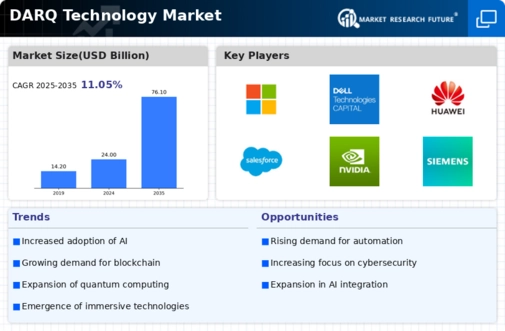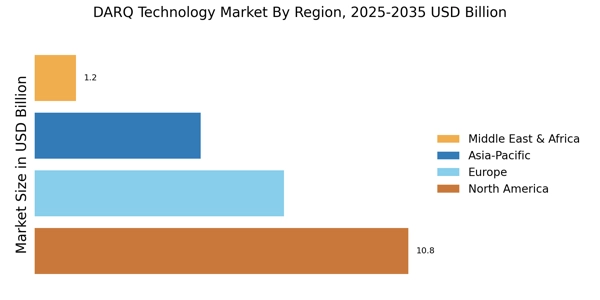Increased Focus on Sustainable Practices
The DARQ Technology Market is also being shaped by an increased focus on sustainable practices. Organizations are increasingly adopting technologies that not only enhance efficiency but also contribute to environmental sustainability. Blockchain, as part of DARQ technologies, offers transparency in supply chains, enabling companies to track and verify sustainable sourcing. This trend is reflected in the growing number of companies committing to sustainability goals, with over 70% of executives indicating that sustainability is a priority for their organizations. As sustainability becomes a core business strategy, the demand for DARQ technologies that support these initiatives is likely to grow.
Rising Demand for Enhanced Security Solutions
The DARQ Technology Market is witnessing a notable increase in demand for enhanced security solutions. As cyber threats become more sophisticated, organizations are compelled to adopt advanced technologies that ensure data integrity and security. Blockchain, a key component of DARQ technologies, offers decentralized security features that are appealing to various sectors, including finance and healthcare. According to recent data, The DARQ Technology Market is projected to reach USD 345.4 billion by 2026, indicating a robust growth trajectory. This trend suggests that businesses are increasingly prioritizing security, thereby driving investments in DARQ technologies that provide innovative solutions to combat cyber risks.
Growing Interest in Decentralized Finance (DeFi)
The DARQ Technology Market is significantly influenced by the growing interest in decentralized finance (DeFi). DeFi platforms leverage blockchain technology to offer financial services without traditional intermediaries, thus enhancing accessibility and reducing costs. The total value locked in DeFi protocols has surged, reaching approximately USD 100 billion in 2025. This rapid growth indicates a shift in how financial transactions are conducted, with an increasing number of users seeking the benefits of transparency and efficiency that DARQ technologies provide. As more individuals and institutions explore DeFi, the demand for related DARQ solutions is likely to expand, further propelling the market.
Expansion of Internet of Things (IoT) Applications
The DARQ Technology Market is significantly impacted by the expansion of Internet of Things (IoT) applications. The proliferation of connected devices is generating vast amounts of data, necessitating advanced technologies for data management and security. The IoT market is expected to reach USD 1.1 trillion by 2026, highlighting the increasing reliance on interconnected systems. As organizations seek to leverage IoT for operational efficiencies, the integration of DARQ technologies becomes essential for ensuring data integrity and security. This trend indicates a growing recognition of the importance of DARQ solutions in managing the complexities associated with IoT deployments.
Advancements in Artificial Intelligence and Machine Learning
The DARQ Technology Market is experiencing a surge in advancements related to artificial intelligence (AI) and machine learning (ML). These technologies are being integrated into various applications, enhancing decision-making processes and operational efficiencies. The AI market is projected to grow to USD 190 billion by 2025, indicating a strong inclination towards automation and intelligent systems. As organizations seek to harness the power of AI and ML, the demand for DARQ technologies that facilitate these integrations is expected to rise. This trend suggests that businesses are increasingly recognizing the potential of DARQ technologies to drive innovation and improve competitive advantage.


















Leave a Comment